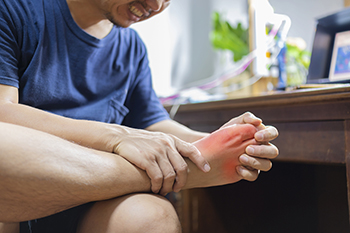If your feet hurt while walking, running, or even standing still for long periods of time, it may be an indication that you need the care of a podiatrist, which is a medical doctor who specializes in problems of the foot and ankle. Other foot problems that may need such attention include bunions, hammertoes, swollen feet and ankles, heel pain, corns or calluses that hurt when you walk, or itching and scaling skin on the feet or toes. Other indications that you may need to see a podiatrist include, pain in the ball of the foot, discoloration of the toes, feet that are cold and sweaty, foot pain while wearing shoes, and pain when walking barefoot. A podiatrist can also help with sports-related injuries and foot or ankle problems resulting from other health conditions, such as diabetes, high blood pressure or obesity. If you have arthritis or rheumatism, a podiatrist can help to address these issues before they cause more serious complications to your feet. Regular visits with a podiatrist may save you from many years of pain and discomfort.
If you are dealing with pain in your feet and ankles, you may want to seek help from a podiatrist. Feel free to contact one of our podiatrists from Advanced Foot & Ankle Medical Center . Our doctors can provide the care you need to keep you pain-free and on your feet.
What Is a Podiatrist?
A podiatrist is a doctor of podiatric medicine who diagnoses and treats conditions of the foot, ankle, and related structures of the leg. Your podiatrist may specialize in a certain field such as sports medicine, wound care, pediatrics, and diabetic care. Podiatrists have the ability to become board certified through training, clinical experience, and then taking an exam.
What Do Podiatrists Do?
On a daily basis, a podiatrist may perform the following activities:
- Diagnose foot ailments such as ulcers, tumors, fractures, etc.
- Use innovative methods to treat conditions
- Use corrective orthotics, casts, and strappings to correct deformities
- Correct walking patterns and balance
- Provide individual consultations to patients
It is very important that you take care of your feet. It’s easy to take having healthy feet for granted, however foot problems tend to be among the most common health conditions. Podiatrists can help diagnose and treat a variety of feet related conditions, so it is crucial that you visit one if you need assistance.
If you have any questions please feel free to contact our office located in Thousand Oaks, CA . We offer the newest diagnostic and treatment technologies for all your foot and ankle needs.










